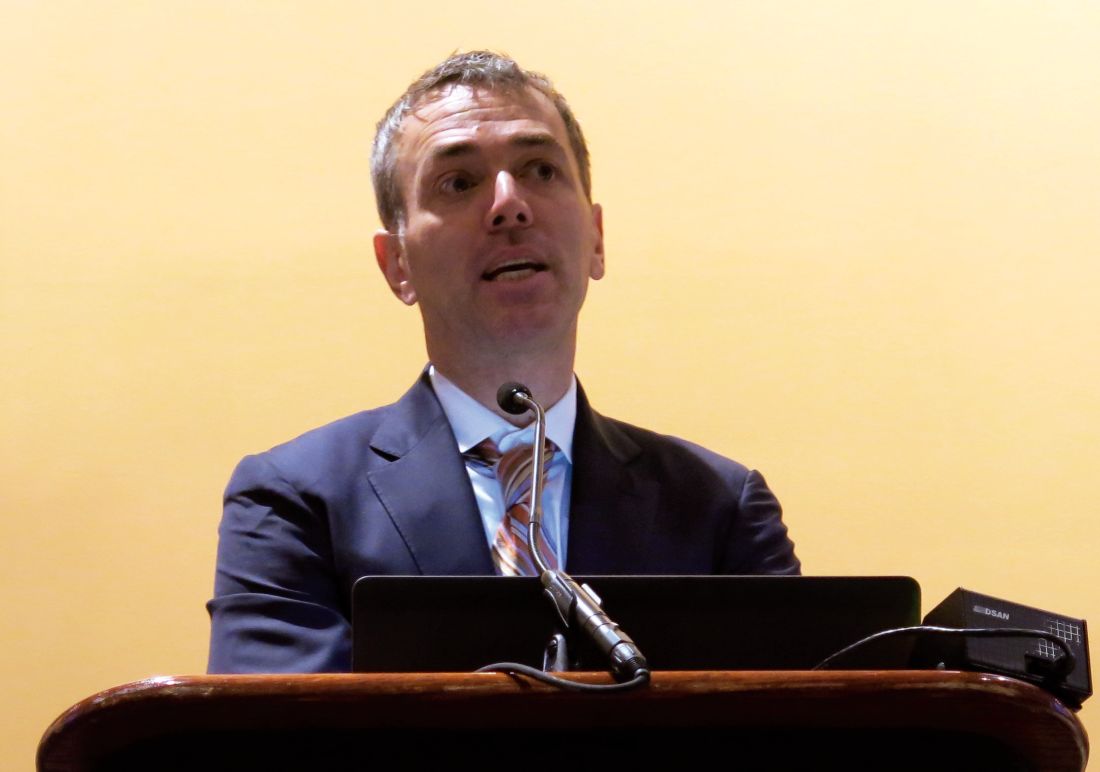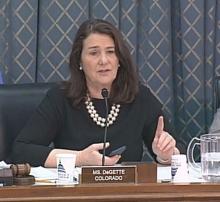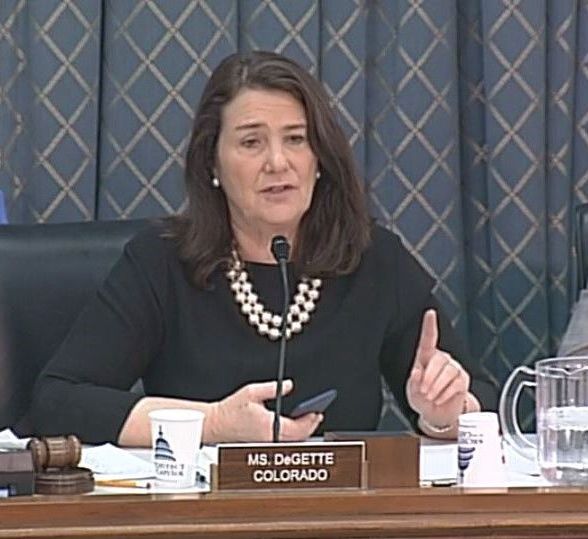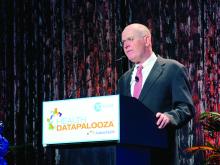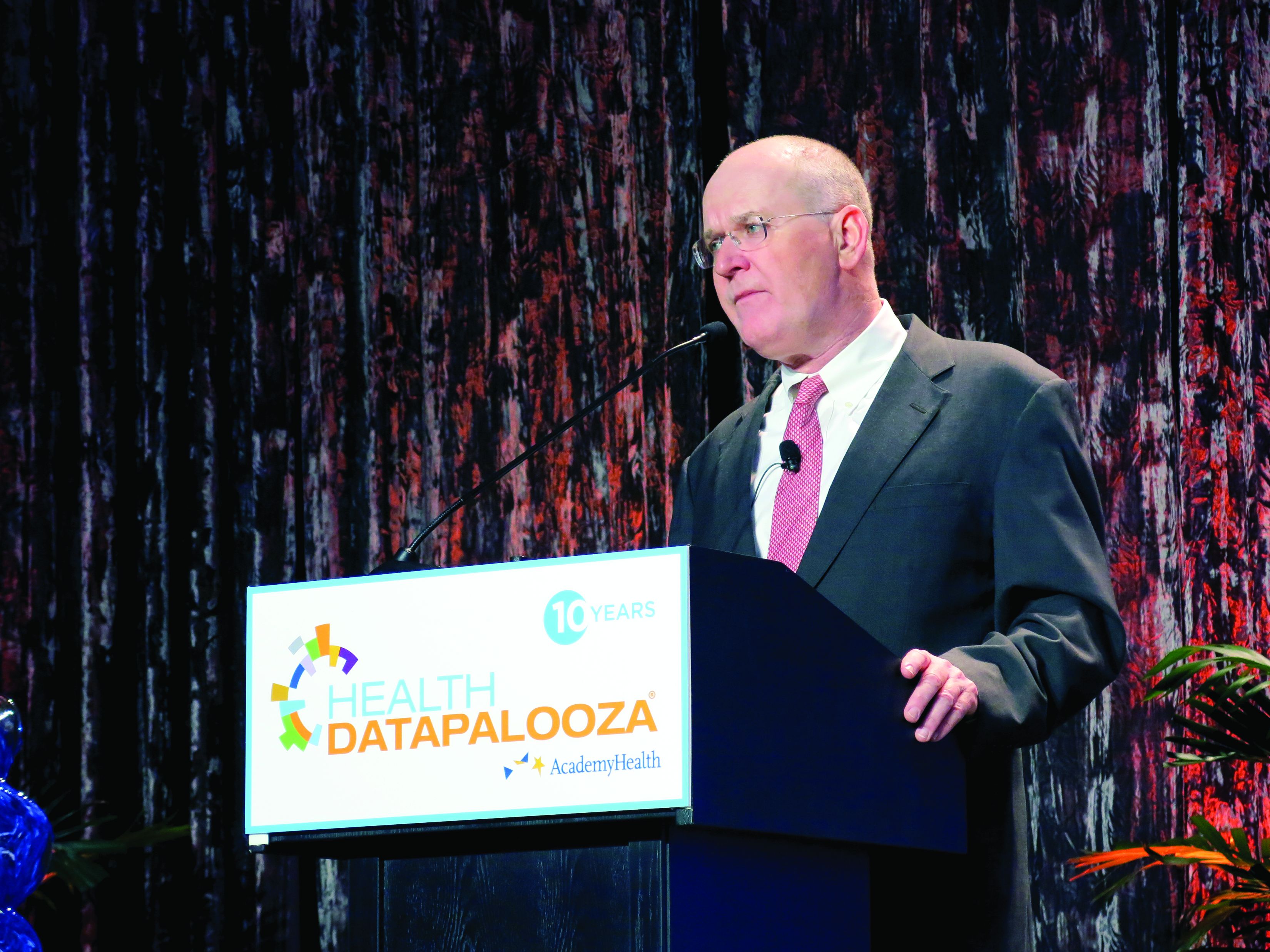User login
CMS plan will incentivize generic drug use
Patients will still be able to use drug manufacturer coupons and pay less at the pharmacy counter, but the money they spend won’t be applied to their out-of-pocket maximum if they choose the brand-name drug with coupon instead of the lower-cost generic.
The change will affect insurance plans offered in the individual market, small-group, large-group, and self-insured–group health plans.
The Centers for Medicare & Medicaid Services backed away from implementing two other generic drug provisions based on feedback on its draft proposal.
The provisions would have allowed insurers to remove brand-name drugs from a formulary midyear when a generic became available or move the drug to a higher tier, and allowed insurers to not count certain drug copayments toward the annual limits if the patient selected a brand-name drug when a generic was available.
“Based on issues raised by commenters, we are not finalizing these proposals,” CMS officials said.
Insurers “making mid-year formulary changes [should] only be permitted to move the brand-name drug to a different cost-sharing tier for the remainder of the plan year. [They] should not be allowed to remove a safe brand-name drug from the formulary until the time of plan renewal,” the American College of Physicians recommended in Feb. 12 comments on the proposal.
The final rule on Notice of Benefit and Payment Parameters for the 2020 benefit year also aims to provide more stability and lower premiums in the exchanges, according to CMS officials.
“The rule issued today will give consumers immediate premium relief by reducing the exchange user fees in the federally facilitated exchanges and state-based exchanges using the federal platform for 2020 thanks to successful efforts to improve the efficiency of the exchange,” CMS Administrator Seema Verma said in a statement.
CMS finalized a proposal to lower exchange user fees by 0.5%, fees that are generally passed on to consumers through premiums.
Other provisions cover exchange-related calculations, including how subsidies for exchange enrollees are calculated and how much enrollees are expected to contribute to benchmark plan premiums, which decreased slightly to 8.24%, down 0.07%, according to a CMS fact sheet.
For the out-of-pocket maximum, CMS said it “finalized a maximum annual limitation on cost sharing of $8,150 for self-only coverage and $16,300 for other than self-only coverage for the 2020 benefit year. This represents an approximately 3.16% increase above the 2019 parameters of $7,900 for self-only coverage and $15,800 for other than self-only coverage.”
Patients will still be able to use drug manufacturer coupons and pay less at the pharmacy counter, but the money they spend won’t be applied to their out-of-pocket maximum if they choose the brand-name drug with coupon instead of the lower-cost generic.
The change will affect insurance plans offered in the individual market, small-group, large-group, and self-insured–group health plans.
The Centers for Medicare & Medicaid Services backed away from implementing two other generic drug provisions based on feedback on its draft proposal.
The provisions would have allowed insurers to remove brand-name drugs from a formulary midyear when a generic became available or move the drug to a higher tier, and allowed insurers to not count certain drug copayments toward the annual limits if the patient selected a brand-name drug when a generic was available.
“Based on issues raised by commenters, we are not finalizing these proposals,” CMS officials said.
Insurers “making mid-year formulary changes [should] only be permitted to move the brand-name drug to a different cost-sharing tier for the remainder of the plan year. [They] should not be allowed to remove a safe brand-name drug from the formulary until the time of plan renewal,” the American College of Physicians recommended in Feb. 12 comments on the proposal.
The final rule on Notice of Benefit and Payment Parameters for the 2020 benefit year also aims to provide more stability and lower premiums in the exchanges, according to CMS officials.
“The rule issued today will give consumers immediate premium relief by reducing the exchange user fees in the federally facilitated exchanges and state-based exchanges using the federal platform for 2020 thanks to successful efforts to improve the efficiency of the exchange,” CMS Administrator Seema Verma said in a statement.
CMS finalized a proposal to lower exchange user fees by 0.5%, fees that are generally passed on to consumers through premiums.
Other provisions cover exchange-related calculations, including how subsidies for exchange enrollees are calculated and how much enrollees are expected to contribute to benchmark plan premiums, which decreased slightly to 8.24%, down 0.07%, according to a CMS fact sheet.
For the out-of-pocket maximum, CMS said it “finalized a maximum annual limitation on cost sharing of $8,150 for self-only coverage and $16,300 for other than self-only coverage for the 2020 benefit year. This represents an approximately 3.16% increase above the 2019 parameters of $7,900 for self-only coverage and $15,800 for other than self-only coverage.”
Patients will still be able to use drug manufacturer coupons and pay less at the pharmacy counter, but the money they spend won’t be applied to their out-of-pocket maximum if they choose the brand-name drug with coupon instead of the lower-cost generic.
The change will affect insurance plans offered in the individual market, small-group, large-group, and self-insured–group health plans.
The Centers for Medicare & Medicaid Services backed away from implementing two other generic drug provisions based on feedback on its draft proposal.
The provisions would have allowed insurers to remove brand-name drugs from a formulary midyear when a generic became available or move the drug to a higher tier, and allowed insurers to not count certain drug copayments toward the annual limits if the patient selected a brand-name drug when a generic was available.
“Based on issues raised by commenters, we are not finalizing these proposals,” CMS officials said.
Insurers “making mid-year formulary changes [should] only be permitted to move the brand-name drug to a different cost-sharing tier for the remainder of the plan year. [They] should not be allowed to remove a safe brand-name drug from the formulary until the time of plan renewal,” the American College of Physicians recommended in Feb. 12 comments on the proposal.
The final rule on Notice of Benefit and Payment Parameters for the 2020 benefit year also aims to provide more stability and lower premiums in the exchanges, according to CMS officials.
“The rule issued today will give consumers immediate premium relief by reducing the exchange user fees in the federally facilitated exchanges and state-based exchanges using the federal platform for 2020 thanks to successful efforts to improve the efficiency of the exchange,” CMS Administrator Seema Verma said in a statement.
CMS finalized a proposal to lower exchange user fees by 0.5%, fees that are generally passed on to consumers through premiums.
Other provisions cover exchange-related calculations, including how subsidies for exchange enrollees are calculated and how much enrollees are expected to contribute to benchmark plan premiums, which decreased slightly to 8.24%, down 0.07%, according to a CMS fact sheet.
For the out-of-pocket maximum, CMS said it “finalized a maximum annual limitation on cost sharing of $8,150 for self-only coverage and $16,300 for other than self-only coverage for the 2020 benefit year. This represents an approximately 3.16% increase above the 2019 parameters of $7,900 for self-only coverage and $15,800 for other than self-only coverage.”
Key clinical point: Patients will be able to use drug manufacturer coupons and pay less at the pharmacy counter, but the money they spend won’t be applied to their out-of-pocket maximum if they choose the brand-name drug with coupon instead of the lower-cost generic.
Major finding: The change will affect insurance plans offered in the individual market, small-group, large-group, and self-insured–group health plans.
Study details: Final rule for the Notice of Benefit and Payment Parameters for the 2020 benefit year
Disclosures: None.
Source: Patient Protection and Affordable Care Act; HHS Notice of Benefit and Payment Parameters for 2020. 45 CFR Parts 146, 147, 148, 153, 155, and 156.
How to incorporate the gender wage gap into contract negotiations
PHILADELPHIA – that they need to account for: the gender wage gap.
“Find a lawyer ... that will support your fight for pay equity,” Michael Sinha, MD, advised in a presentation at the annual meeting of the American College of Physicians.
“Definitely interview them,” said Dr. Sinha of Harvard Medical School, Boston. “Get a sense of how committed they are to that cause. Seek recommendations from other women in medicine. Maybe they will point you to the person who really is committed to this cause and wants to help you.”
He also cautioned that physicians might have to help their lawyer fill in the knowledge gap. “Sometimes you need to provide that lawyer with data. There are a lot of reports that have been published from various organizations [including the ACP]. Don’t assume that the lawyer has the evidence.”
Armed with evidence, he said there is opportunity to address gender pay gaps in the contract. “You can put a lot of things into your contract, why not some of these things? If there is institutional evidence of a pay gap or a leaky promotional pipeline, you are telling them you have a problem with salary discrepancies between male and female physicians and I need to protect my own self-worth.”
Dr. Sinha recommended prospective employees develop strategies with their lawyers, which could mean letting the lawyer take the lead in the negotiations.
“Maybe that reduces stress or emotion in the process. That will preserve a good relationship with the employer,” he said. “A confident, knowledgeable lawyer may help mitigate gender differences in negotiation strategy.”
In order to help close the gender gap, Dr. Sinha said he advises his male colleagues to help female physicians by being open about their compensation, especially if compensation is not public information. “I have been encouraging male physician colleagues of mine to share that information when you are asked. Don’t make it impossible for someone to figure out.”
He noted that it is not likely that closing the gender gap by raising women’s compensation is going to result in male physicians losing money, but rather in the long run it will mean better compensation for everyone.
Dr. Sinha also had this advice for employers: “Before you do anything else, level your pay gap. ... For every physician that works in your organization, level your pay gap. Offer equitable salary packages up front to men and women. Understand your responsibilities under federal and state equal pay laws.”
When it comes to equitable compensation packages, all offerings, including salary and fringe benefits, should be offered to both male and female physicians or to neither.
“Don’t make something nonnegotiable for women but engage men in negotiations,” he said. “I think that is obvious but I have seen that happen.”
Dr. Sinha also said it is important to check your gender biases at the door before entering negotiations. Don’t view a woman asking for something as demanding or harsh when a male asking for the same exact thing is viewed as assertive and self-confident.
“Don’t fall into those traps. And if you have people that can call out your biases and help you see that, that’s important,” Dr. Sinha noted.
He also stated that hiring committees need to show diversity in terms of gender, race, and ethnicity, adding that it is “hugely important” that you do that.
The bottom line is to not force women to negotiate for equal pay, Dr. Sinha noted. “The gender gap is well documented in medicine, and you really have to do your part.”
PHILADELPHIA – that they need to account for: the gender wage gap.
“Find a lawyer ... that will support your fight for pay equity,” Michael Sinha, MD, advised in a presentation at the annual meeting of the American College of Physicians.
“Definitely interview them,” said Dr. Sinha of Harvard Medical School, Boston. “Get a sense of how committed they are to that cause. Seek recommendations from other women in medicine. Maybe they will point you to the person who really is committed to this cause and wants to help you.”
He also cautioned that physicians might have to help their lawyer fill in the knowledge gap. “Sometimes you need to provide that lawyer with data. There are a lot of reports that have been published from various organizations [including the ACP]. Don’t assume that the lawyer has the evidence.”
Armed with evidence, he said there is opportunity to address gender pay gaps in the contract. “You can put a lot of things into your contract, why not some of these things? If there is institutional evidence of a pay gap or a leaky promotional pipeline, you are telling them you have a problem with salary discrepancies between male and female physicians and I need to protect my own self-worth.”
Dr. Sinha recommended prospective employees develop strategies with their lawyers, which could mean letting the lawyer take the lead in the negotiations.
“Maybe that reduces stress or emotion in the process. That will preserve a good relationship with the employer,” he said. “A confident, knowledgeable lawyer may help mitigate gender differences in negotiation strategy.”
In order to help close the gender gap, Dr. Sinha said he advises his male colleagues to help female physicians by being open about their compensation, especially if compensation is not public information. “I have been encouraging male physician colleagues of mine to share that information when you are asked. Don’t make it impossible for someone to figure out.”
He noted that it is not likely that closing the gender gap by raising women’s compensation is going to result in male physicians losing money, but rather in the long run it will mean better compensation for everyone.
Dr. Sinha also had this advice for employers: “Before you do anything else, level your pay gap. ... For every physician that works in your organization, level your pay gap. Offer equitable salary packages up front to men and women. Understand your responsibilities under federal and state equal pay laws.”
When it comes to equitable compensation packages, all offerings, including salary and fringe benefits, should be offered to both male and female physicians or to neither.
“Don’t make something nonnegotiable for women but engage men in negotiations,” he said. “I think that is obvious but I have seen that happen.”
Dr. Sinha also said it is important to check your gender biases at the door before entering negotiations. Don’t view a woman asking for something as demanding or harsh when a male asking for the same exact thing is viewed as assertive and self-confident.
“Don’t fall into those traps. And if you have people that can call out your biases and help you see that, that’s important,” Dr. Sinha noted.
He also stated that hiring committees need to show diversity in terms of gender, race, and ethnicity, adding that it is “hugely important” that you do that.
The bottom line is to not force women to negotiate for equal pay, Dr. Sinha noted. “The gender gap is well documented in medicine, and you really have to do your part.”
PHILADELPHIA – that they need to account for: the gender wage gap.
“Find a lawyer ... that will support your fight for pay equity,” Michael Sinha, MD, advised in a presentation at the annual meeting of the American College of Physicians.
“Definitely interview them,” said Dr. Sinha of Harvard Medical School, Boston. “Get a sense of how committed they are to that cause. Seek recommendations from other women in medicine. Maybe they will point you to the person who really is committed to this cause and wants to help you.”
He also cautioned that physicians might have to help their lawyer fill in the knowledge gap. “Sometimes you need to provide that lawyer with data. There are a lot of reports that have been published from various organizations [including the ACP]. Don’t assume that the lawyer has the evidence.”
Armed with evidence, he said there is opportunity to address gender pay gaps in the contract. “You can put a lot of things into your contract, why not some of these things? If there is institutional evidence of a pay gap or a leaky promotional pipeline, you are telling them you have a problem with salary discrepancies between male and female physicians and I need to protect my own self-worth.”
Dr. Sinha recommended prospective employees develop strategies with their lawyers, which could mean letting the lawyer take the lead in the negotiations.
“Maybe that reduces stress or emotion in the process. That will preserve a good relationship with the employer,” he said. “A confident, knowledgeable lawyer may help mitigate gender differences in negotiation strategy.”
In order to help close the gender gap, Dr. Sinha said he advises his male colleagues to help female physicians by being open about their compensation, especially if compensation is not public information. “I have been encouraging male physician colleagues of mine to share that information when you are asked. Don’t make it impossible for someone to figure out.”
He noted that it is not likely that closing the gender gap by raising women’s compensation is going to result in male physicians losing money, but rather in the long run it will mean better compensation for everyone.
Dr. Sinha also had this advice for employers: “Before you do anything else, level your pay gap. ... For every physician that works in your organization, level your pay gap. Offer equitable salary packages up front to men and women. Understand your responsibilities under federal and state equal pay laws.”
When it comes to equitable compensation packages, all offerings, including salary and fringe benefits, should be offered to both male and female physicians or to neither.
“Don’t make something nonnegotiable for women but engage men in negotiations,” he said. “I think that is obvious but I have seen that happen.”
Dr. Sinha also said it is important to check your gender biases at the door before entering negotiations. Don’t view a woman asking for something as demanding or harsh when a male asking for the same exact thing is viewed as assertive and self-confident.
“Don’t fall into those traps. And if you have people that can call out your biases and help you see that, that’s important,” Dr. Sinha noted.
He also stated that hiring committees need to show diversity in terms of gender, race, and ethnicity, adding that it is “hugely important” that you do that.
The bottom line is to not force women to negotiate for equal pay, Dr. Sinha noted. “The gender gap is well documented in medicine, and you really have to do your part.”
REPORTING FROM INTERNAL MEDICINE 2019
MAT access helps address opioid use disorder
PHILADELPHIA –
That was the key takeaway from a presentation given by Charles Reznikoff, MD, at the annual meeting of the American College of Physicians.
“There is fairly robust evidence on medication assisted therapy for OUD [opioid use disorder],” said Dr. Reznikoff of the University of Minnesota, Minneapolis. “MAT lowers mortality 70% in people with OUD all-cause mortality.”
He mentioned some examples in Europe, where access to medication assisted therapy has had a dramatic effect on opioid overdoses and deaths.
For example, any doctor in France since 1995 can prescribe drugs to help with OUD treatment and most buprenorphine prescriptions are written by primary care physicians. As a result, there has been a tenfold increase in the number of patients suffering from OUD receiving medication assisted treatment. In addition, there has been an 80% drop in the overdose death rate.
But Dr. Reznikoff’s recommendation on the need for more MAT was more about methadone and Suboxone, which contains a combination of buprenorphine and naloxone, than the current drive to expand the distribution of naloxone alone. He noted that naloxone is good but it really serves as a short-term fix that slows the rate of overdose deaths and provides time to implement other long-term fixes. Many states are providing naloxone to first responders to help treat patients who are overdosing on opioids, but little is being done to expand access to other medication assisted treatments, he said.
“I am bringing it up to try to illustrate what is happening in American policy making that we are reaching for naloxone first and we are not reaching for MAT first,” Dr. Reznikoff said, noting that you can give naloxone to patients without changing the underlying system of care.
He also stressed the need to get more medication assisted treatment into the penal system.
“If you have opioid use disorder [and] you are incarcerated, almost nowhere in America can you get medication assisted therapy while incarcerated,” Dr. Reznikoff said. “You lose your tolerance, but you still have addiction. You are released from incarceration and your rate of death is 20-fold the average OUD rate of death in the first 2 weeks after release.”
As a counter example, he noted that Portugal in 2001 switched its approach to OUD from criminal to a public health issue and stopped incarcerating people with opioid addiction. This led to a decrease by 75% in active heroin users, and the country now boasts the lowest rate of drug-related death in Western Europe, 1/50th of the rate in America.
“We pretty strongly believe that if they were given medication while incarcerated or just not incarcerated, they would not have that 20-fold risk of death after release,” he said. “Incarceration is actually an accelerant in the opioid epidemic and we are not going to get out of this without addressing that tough issue.”
Another effective policy option that should be expanded further is the use of prescription drug monitoring programs, which can be effective in controlling the amount of prescriptions written, said Rebecca Haffajee, PhD, assistant professor, health management and policy, University of Michigan School of Public Health, Ann Arbor.
“We do have good evidence on the prescribing outcomes and particularly attributable to a few key features, [such as] use mandates, registration mandates, delegate access, all of those features have been shown across different types of patient populations – Medicaid, Medicare, commercially insured – to reduce overall opioid prescribing and some high risk measures, polypharmacy, doctor shopping, pharmacy shopping, those sorts of things,” noted Dr. Haffajee.
Twenty percent of state laws enacted to address the opioid crisis have involved prescription drug monitoring programs, she added.
There is not enough evidence to determine whether other laws, such as those that limit quantity and dosage levels, are effective in the fight against opioid use disorder, added Dr. Reznikoff.
The speakers did not report any conflicts.
PHILADELPHIA –
That was the key takeaway from a presentation given by Charles Reznikoff, MD, at the annual meeting of the American College of Physicians.
“There is fairly robust evidence on medication assisted therapy for OUD [opioid use disorder],” said Dr. Reznikoff of the University of Minnesota, Minneapolis. “MAT lowers mortality 70% in people with OUD all-cause mortality.”
He mentioned some examples in Europe, where access to medication assisted therapy has had a dramatic effect on opioid overdoses and deaths.
For example, any doctor in France since 1995 can prescribe drugs to help with OUD treatment and most buprenorphine prescriptions are written by primary care physicians. As a result, there has been a tenfold increase in the number of patients suffering from OUD receiving medication assisted treatment. In addition, there has been an 80% drop in the overdose death rate.
But Dr. Reznikoff’s recommendation on the need for more MAT was more about methadone and Suboxone, which contains a combination of buprenorphine and naloxone, than the current drive to expand the distribution of naloxone alone. He noted that naloxone is good but it really serves as a short-term fix that slows the rate of overdose deaths and provides time to implement other long-term fixes. Many states are providing naloxone to first responders to help treat patients who are overdosing on opioids, but little is being done to expand access to other medication assisted treatments, he said.
“I am bringing it up to try to illustrate what is happening in American policy making that we are reaching for naloxone first and we are not reaching for MAT first,” Dr. Reznikoff said, noting that you can give naloxone to patients without changing the underlying system of care.
He also stressed the need to get more medication assisted treatment into the penal system.
“If you have opioid use disorder [and] you are incarcerated, almost nowhere in America can you get medication assisted therapy while incarcerated,” Dr. Reznikoff said. “You lose your tolerance, but you still have addiction. You are released from incarceration and your rate of death is 20-fold the average OUD rate of death in the first 2 weeks after release.”
As a counter example, he noted that Portugal in 2001 switched its approach to OUD from criminal to a public health issue and stopped incarcerating people with opioid addiction. This led to a decrease by 75% in active heroin users, and the country now boasts the lowest rate of drug-related death in Western Europe, 1/50th of the rate in America.
“We pretty strongly believe that if they were given medication while incarcerated or just not incarcerated, they would not have that 20-fold risk of death after release,” he said. “Incarceration is actually an accelerant in the opioid epidemic and we are not going to get out of this without addressing that tough issue.”
Another effective policy option that should be expanded further is the use of prescription drug monitoring programs, which can be effective in controlling the amount of prescriptions written, said Rebecca Haffajee, PhD, assistant professor, health management and policy, University of Michigan School of Public Health, Ann Arbor.
“We do have good evidence on the prescribing outcomes and particularly attributable to a few key features, [such as] use mandates, registration mandates, delegate access, all of those features have been shown across different types of patient populations – Medicaid, Medicare, commercially insured – to reduce overall opioid prescribing and some high risk measures, polypharmacy, doctor shopping, pharmacy shopping, those sorts of things,” noted Dr. Haffajee.
Twenty percent of state laws enacted to address the opioid crisis have involved prescription drug monitoring programs, she added.
There is not enough evidence to determine whether other laws, such as those that limit quantity and dosage levels, are effective in the fight against opioid use disorder, added Dr. Reznikoff.
The speakers did not report any conflicts.
PHILADELPHIA –
That was the key takeaway from a presentation given by Charles Reznikoff, MD, at the annual meeting of the American College of Physicians.
“There is fairly robust evidence on medication assisted therapy for OUD [opioid use disorder],” said Dr. Reznikoff of the University of Minnesota, Minneapolis. “MAT lowers mortality 70% in people with OUD all-cause mortality.”
He mentioned some examples in Europe, where access to medication assisted therapy has had a dramatic effect on opioid overdoses and deaths.
For example, any doctor in France since 1995 can prescribe drugs to help with OUD treatment and most buprenorphine prescriptions are written by primary care physicians. As a result, there has been a tenfold increase in the number of patients suffering from OUD receiving medication assisted treatment. In addition, there has been an 80% drop in the overdose death rate.
But Dr. Reznikoff’s recommendation on the need for more MAT was more about methadone and Suboxone, which contains a combination of buprenorphine and naloxone, than the current drive to expand the distribution of naloxone alone. He noted that naloxone is good but it really serves as a short-term fix that slows the rate of overdose deaths and provides time to implement other long-term fixes. Many states are providing naloxone to first responders to help treat patients who are overdosing on opioids, but little is being done to expand access to other medication assisted treatments, he said.
“I am bringing it up to try to illustrate what is happening in American policy making that we are reaching for naloxone first and we are not reaching for MAT first,” Dr. Reznikoff said, noting that you can give naloxone to patients without changing the underlying system of care.
He also stressed the need to get more medication assisted treatment into the penal system.
“If you have opioid use disorder [and] you are incarcerated, almost nowhere in America can you get medication assisted therapy while incarcerated,” Dr. Reznikoff said. “You lose your tolerance, but you still have addiction. You are released from incarceration and your rate of death is 20-fold the average OUD rate of death in the first 2 weeks after release.”
As a counter example, he noted that Portugal in 2001 switched its approach to OUD from criminal to a public health issue and stopped incarcerating people with opioid addiction. This led to a decrease by 75% in active heroin users, and the country now boasts the lowest rate of drug-related death in Western Europe, 1/50th of the rate in America.
“We pretty strongly believe that if they were given medication while incarcerated or just not incarcerated, they would not have that 20-fold risk of death after release,” he said. “Incarceration is actually an accelerant in the opioid epidemic and we are not going to get out of this without addressing that tough issue.”
Another effective policy option that should be expanded further is the use of prescription drug monitoring programs, which can be effective in controlling the amount of prescriptions written, said Rebecca Haffajee, PhD, assistant professor, health management and policy, University of Michigan School of Public Health, Ann Arbor.
“We do have good evidence on the prescribing outcomes and particularly attributable to a few key features, [such as] use mandates, registration mandates, delegate access, all of those features have been shown across different types of patient populations – Medicaid, Medicare, commercially insured – to reduce overall opioid prescribing and some high risk measures, polypharmacy, doctor shopping, pharmacy shopping, those sorts of things,” noted Dr. Haffajee.
Twenty percent of state laws enacted to address the opioid crisis have involved prescription drug monitoring programs, she added.
There is not enough evidence to determine whether other laws, such as those that limit quantity and dosage levels, are effective in the fight against opioid use disorder, added Dr. Reznikoff.
The speakers did not report any conflicts.
REPORTING FROM INTERNAL MEDICINE 2019
Transformational change starts within medical practices
PHILADELPHIA –
At least one physician can attest to this.
Priya Radhakrishnan, MD, chief academic officer at HonorHealth Medical Group, Phoenix, described one of her earliest successes in working on the Transforming Clinical Practice Initiative as her literal and figurative opening of the door between a behavioral health office and a physician health office.
In her example, which she presented in a panel on transformational change at the annual meeting of the American College of Physicians, both the behavioral health office and the physician office coordinated to have the same Medicaid patients. Because of that, when the behavioral health specialist learned of a physical condition, a “warm hand-off” was made simply by walking the patient into the doctor’s office, she said.
Transformational changes in the delivery of health care can come from events and opportunities within your medical practice. And your practice data can be the tools that guide you to make the change happen, noted Dr. Radhakrishnan and her copanelists, during the April 12 session. The panelists focused their presentation on lessons learned from the ongoing Transforming Clinical Practice Initiative, a test project of the Centers for Medicare & Medicaid Services’ Center for Medicare and Medicaid Innovation. The project is providing assistance to physicians and practices looking to transform their organizations into using value-based care delivery models.
“I think most of us don’t realize how much power we hold over the ability to change health care within our neighborhood,” said Thomas Spain, MD, of Vanderbilt University Medical Center, Nashville, Tenn., during his presentation. “[We] have been lulled into this idea that health care will change ... when someone in Washington, D.C., finally makes a change.”
Actually, specific events in a single practice typically drive changes, he said. Most physicians who made these changes “really had very little interest in [practice changes]; then something would happen. It was a patient experience that they had, a family experience, a new program that came along” that made them realize there is an opportunity here for a physician to take the lead and make a change.
And, invariably, those physicians discovered “new satisfaction in their work through the process ... [their] practices looked very different at the end of the project,” Dr. Spain noted.
The other component to the success was looking differently at data to assure continuous data-driven quality improvement, said copanelist M. Carol Greenlee, MD, an endocrinologist and chair and counsel of subspecialty societies at ACP.
Data aren’t just about “being judged [and] not getting penalized,” she said. Data need to be viewed as a tool to really help understand the needs of the patient and the population.
Change makers “had to [ask], ‘For my population, how do I reduce admissions, what are the unnecessary tests my patients are getting, what are the unnecessary procedures?’ ” she said. Through the Transforming Clinical Practice Initiative, “we are teaching [participants] how to use data to show their value to payers ... and to find their voice in sharing their value.”
Some of the aims of the program included building solutions that were scalable, reducing unnecessary hospital admissions, generating $1 billion to $4 billion in savings, and transitioning 75% of practices completing the program to alternative payment models.
Dr. Spain noted that something as simple as moving the “if this is a medical emergency” disclaimer to the end of the outbound message at the physician office could help reduce trips to the emergency department. This could instead bring the patient to the office.
“Start small,” Dr. Radhakrishnan advised. “Value and quality freaks all of us out.”
Target small successes that can be built upon.
“Care delivery is the final mile,” Dr. Greenlee added. “We have all this medical knowledge, all the science and clinical research, and we know what to do with our guidelines, but if we don’t have care delivery, that final mile of [improving] ... the health of our patients, all of this is for naught.”
PHILADELPHIA –
At least one physician can attest to this.
Priya Radhakrishnan, MD, chief academic officer at HonorHealth Medical Group, Phoenix, described one of her earliest successes in working on the Transforming Clinical Practice Initiative as her literal and figurative opening of the door between a behavioral health office and a physician health office.
In her example, which she presented in a panel on transformational change at the annual meeting of the American College of Physicians, both the behavioral health office and the physician office coordinated to have the same Medicaid patients. Because of that, when the behavioral health specialist learned of a physical condition, a “warm hand-off” was made simply by walking the patient into the doctor’s office, she said.
Transformational changes in the delivery of health care can come from events and opportunities within your medical practice. And your practice data can be the tools that guide you to make the change happen, noted Dr. Radhakrishnan and her copanelists, during the April 12 session. The panelists focused their presentation on lessons learned from the ongoing Transforming Clinical Practice Initiative, a test project of the Centers for Medicare & Medicaid Services’ Center for Medicare and Medicaid Innovation. The project is providing assistance to physicians and practices looking to transform their organizations into using value-based care delivery models.
“I think most of us don’t realize how much power we hold over the ability to change health care within our neighborhood,” said Thomas Spain, MD, of Vanderbilt University Medical Center, Nashville, Tenn., during his presentation. “[We] have been lulled into this idea that health care will change ... when someone in Washington, D.C., finally makes a change.”
Actually, specific events in a single practice typically drive changes, he said. Most physicians who made these changes “really had very little interest in [practice changes]; then something would happen. It was a patient experience that they had, a family experience, a new program that came along” that made them realize there is an opportunity here for a physician to take the lead and make a change.
And, invariably, those physicians discovered “new satisfaction in their work through the process ... [their] practices looked very different at the end of the project,” Dr. Spain noted.
The other component to the success was looking differently at data to assure continuous data-driven quality improvement, said copanelist M. Carol Greenlee, MD, an endocrinologist and chair and counsel of subspecialty societies at ACP.
Data aren’t just about “being judged [and] not getting penalized,” she said. Data need to be viewed as a tool to really help understand the needs of the patient and the population.
Change makers “had to [ask], ‘For my population, how do I reduce admissions, what are the unnecessary tests my patients are getting, what are the unnecessary procedures?’ ” she said. Through the Transforming Clinical Practice Initiative, “we are teaching [participants] how to use data to show their value to payers ... and to find their voice in sharing their value.”
Some of the aims of the program included building solutions that were scalable, reducing unnecessary hospital admissions, generating $1 billion to $4 billion in savings, and transitioning 75% of practices completing the program to alternative payment models.
Dr. Spain noted that something as simple as moving the “if this is a medical emergency” disclaimer to the end of the outbound message at the physician office could help reduce trips to the emergency department. This could instead bring the patient to the office.
“Start small,” Dr. Radhakrishnan advised. “Value and quality freaks all of us out.”
Target small successes that can be built upon.
“Care delivery is the final mile,” Dr. Greenlee added. “We have all this medical knowledge, all the science and clinical research, and we know what to do with our guidelines, but if we don’t have care delivery, that final mile of [improving] ... the health of our patients, all of this is for naught.”
PHILADELPHIA –
At least one physician can attest to this.
Priya Radhakrishnan, MD, chief academic officer at HonorHealth Medical Group, Phoenix, described one of her earliest successes in working on the Transforming Clinical Practice Initiative as her literal and figurative opening of the door between a behavioral health office and a physician health office.
In her example, which she presented in a panel on transformational change at the annual meeting of the American College of Physicians, both the behavioral health office and the physician office coordinated to have the same Medicaid patients. Because of that, when the behavioral health specialist learned of a physical condition, a “warm hand-off” was made simply by walking the patient into the doctor’s office, she said.
Transformational changes in the delivery of health care can come from events and opportunities within your medical practice. And your practice data can be the tools that guide you to make the change happen, noted Dr. Radhakrishnan and her copanelists, during the April 12 session. The panelists focused their presentation on lessons learned from the ongoing Transforming Clinical Practice Initiative, a test project of the Centers for Medicare & Medicaid Services’ Center for Medicare and Medicaid Innovation. The project is providing assistance to physicians and practices looking to transform their organizations into using value-based care delivery models.
“I think most of us don’t realize how much power we hold over the ability to change health care within our neighborhood,” said Thomas Spain, MD, of Vanderbilt University Medical Center, Nashville, Tenn., during his presentation. “[We] have been lulled into this idea that health care will change ... when someone in Washington, D.C., finally makes a change.”
Actually, specific events in a single practice typically drive changes, he said. Most physicians who made these changes “really had very little interest in [practice changes]; then something would happen. It was a patient experience that they had, a family experience, a new program that came along” that made them realize there is an opportunity here for a physician to take the lead and make a change.
And, invariably, those physicians discovered “new satisfaction in their work through the process ... [their] practices looked very different at the end of the project,” Dr. Spain noted.
The other component to the success was looking differently at data to assure continuous data-driven quality improvement, said copanelist M. Carol Greenlee, MD, an endocrinologist and chair and counsel of subspecialty societies at ACP.
Data aren’t just about “being judged [and] not getting penalized,” she said. Data need to be viewed as a tool to really help understand the needs of the patient and the population.
Change makers “had to [ask], ‘For my population, how do I reduce admissions, what are the unnecessary tests my patients are getting, what are the unnecessary procedures?’ ” she said. Through the Transforming Clinical Practice Initiative, “we are teaching [participants] how to use data to show their value to payers ... and to find their voice in sharing their value.”
Some of the aims of the program included building solutions that were scalable, reducing unnecessary hospital admissions, generating $1 billion to $4 billion in savings, and transitioning 75% of practices completing the program to alternative payment models.
Dr. Spain noted that something as simple as moving the “if this is a medical emergency” disclaimer to the end of the outbound message at the physician office could help reduce trips to the emergency department. This could instead bring the patient to the office.
“Start small,” Dr. Radhakrishnan advised. “Value and quality freaks all of us out.”
Target small successes that can be built upon.
“Care delivery is the final mile,” Dr. Greenlee added. “We have all this medical knowledge, all the science and clinical research, and we know what to do with our guidelines, but if we don’t have care delivery, that final mile of [improving] ... the health of our patients, all of this is for naught.”
REPORTING FROM INTERNAL MEDICINE 2019
Negotiating an employment contract? Lawyer up
advised in a presentation at the annual meeting of the American College of Physicians.
In a presentation that outlined the essentials of reviewing an employment contract, Dr. Sinha of Harvard Medical School, Boston, advised hiring a lawyer with expertise in health care law and health care employment contracts once the letter of intent has been received. Understanding the contract process is helpful, “but ultimately the lawyer is going to be the one helping you with regional expertise. Perhaps they have already interacted with this employer and have a long-standing relationship. They are going to know state laws that are relevant to you. They are going to have a lot of insights that you are just not going to be able to bring to the table very easily.”
A lawyer also will have expertise in negotiation. “If you can form an alliance and negotiate as a team, you are much more likely to get the things you want out of a negotiation,” he said.
Dr. Sinha advised going into a contract knowing exactly what you want. He recommended coming up with six or seven things that matter to you, such as base pay and bonus structure, fringe benefits, relocation expenses, work hours and locations, terms, employee versus independent contractor, and no compete clauses. Even if you have only three key things you’re looking for out of the negotiations, still try to come up with six or seven items.
To get the best results, you need to do your homework. Find out starting salaries and use salary scales when available. Get a sense of who the prospective employer is, what their needs are, and who is competing with you for that contract. Talk to the staff to get a sense of what the work environment is like.
“And then, really speak to people in the community. ... I think this [factor] gets overlooked,” he said. “You can get a lot of valuable information, get a sense of public perception about a physician group, a hospital, a medical school. Those are important considerations as well.”
He also stressed understanding the economic viability of the organization and the growth opportunities for the organization, and recommended reading the contract multiple times. “Understanding the contract is the key to being able to negotiate the provisions.”
Finally, he emphasized that there is no need to accept the first offer made.
“There is always room for negotiating and the bottom line is both sides have to be happy with the contract they negotiated,” he said.
advised in a presentation at the annual meeting of the American College of Physicians.
In a presentation that outlined the essentials of reviewing an employment contract, Dr. Sinha of Harvard Medical School, Boston, advised hiring a lawyer with expertise in health care law and health care employment contracts once the letter of intent has been received. Understanding the contract process is helpful, “but ultimately the lawyer is going to be the one helping you with regional expertise. Perhaps they have already interacted with this employer and have a long-standing relationship. They are going to know state laws that are relevant to you. They are going to have a lot of insights that you are just not going to be able to bring to the table very easily.”
A lawyer also will have expertise in negotiation. “If you can form an alliance and negotiate as a team, you are much more likely to get the things you want out of a negotiation,” he said.
Dr. Sinha advised going into a contract knowing exactly what you want. He recommended coming up with six or seven things that matter to you, such as base pay and bonus structure, fringe benefits, relocation expenses, work hours and locations, terms, employee versus independent contractor, and no compete clauses. Even if you have only three key things you’re looking for out of the negotiations, still try to come up with six or seven items.
To get the best results, you need to do your homework. Find out starting salaries and use salary scales when available. Get a sense of who the prospective employer is, what their needs are, and who is competing with you for that contract. Talk to the staff to get a sense of what the work environment is like.
“And then, really speak to people in the community. ... I think this [factor] gets overlooked,” he said. “You can get a lot of valuable information, get a sense of public perception about a physician group, a hospital, a medical school. Those are important considerations as well.”
He also stressed understanding the economic viability of the organization and the growth opportunities for the organization, and recommended reading the contract multiple times. “Understanding the contract is the key to being able to negotiate the provisions.”
Finally, he emphasized that there is no need to accept the first offer made.
“There is always room for negotiating and the bottom line is both sides have to be happy with the contract they negotiated,” he said.
advised in a presentation at the annual meeting of the American College of Physicians.
In a presentation that outlined the essentials of reviewing an employment contract, Dr. Sinha of Harvard Medical School, Boston, advised hiring a lawyer with expertise in health care law and health care employment contracts once the letter of intent has been received. Understanding the contract process is helpful, “but ultimately the lawyer is going to be the one helping you with regional expertise. Perhaps they have already interacted with this employer and have a long-standing relationship. They are going to know state laws that are relevant to you. They are going to have a lot of insights that you are just not going to be able to bring to the table very easily.”
A lawyer also will have expertise in negotiation. “If you can form an alliance and negotiate as a team, you are much more likely to get the things you want out of a negotiation,” he said.
Dr. Sinha advised going into a contract knowing exactly what you want. He recommended coming up with six or seven things that matter to you, such as base pay and bonus structure, fringe benefits, relocation expenses, work hours and locations, terms, employee versus independent contractor, and no compete clauses. Even if you have only three key things you’re looking for out of the negotiations, still try to come up with six or seven items.
To get the best results, you need to do your homework. Find out starting salaries and use salary scales when available. Get a sense of who the prospective employer is, what their needs are, and who is competing with you for that contract. Talk to the staff to get a sense of what the work environment is like.
“And then, really speak to people in the community. ... I think this [factor] gets overlooked,” he said. “You can get a lot of valuable information, get a sense of public perception about a physician group, a hospital, a medical school. Those are important considerations as well.”
He also stressed understanding the economic viability of the organization and the growth opportunities for the organization, and recommended reading the contract multiple times. “Understanding the contract is the key to being able to negotiate the provisions.”
Finally, he emphasized that there is no need to accept the first offer made.
“There is always room for negotiating and the bottom line is both sides have to be happy with the contract they negotiated,” he said.
REPORTING FROM INTERNAL MEDICINE 2019
Bipartisanship breaks out at House hearing on insulin prices
Who’s responsible for the rising cost of insulin? Manufacturers and pharmacy benefit managers pointed their fingers at each other on April 10 at a congressional hearing.
In response, Democrats and Republicans on the House Energy & Commerce Subcommittee on Oversight and Investigations said they might just take matters into their own hands.
Rebates and discounts are the drivers, according to leaders from three insulin manufacturers.
Mike Mason, a senior vice president of Eli Lilly & Co., was put on the defensive immediately by Subcommittee Chairman Diana DeGette (D-Colo.), who asked him to justify the increases in list prices during the last 10 years.
“Seventy-five percent of our list price is paid for rebates and discounts to secure access so people have affordable access,” Mr. Mason said.
He was cut off in his response as Rep. DeGette pressed further: “So that’s what’s making the price go up and up.”
To which Mr. Mason responded, “$210 of a vial of Humalog is paid for discounts and rebates.” It was noted during the hearing that a vial has a list price of $275.
Doug Langa, an executive vice president at Novo Nordisk, agreed. “There is significant demand for rebates.”
Kathleen Tregoning, an executive vice president at Sanofi, added that, as part of setting the list price, “we have to look at the dynamics of the supply chain, including the rebates.”
Leaders of several pharmacy benefit managers disagreed.
Rep. DeGette asked Thomas M. Moriarty, an executive vice president and general counsel at CVS Health whether he thought rebates were forcing manufacturers to raise list prices. His response? “I do not, no.”
Amy Bricker, a senior vice president at Express Scripts concurred. “I have no idea why list prices are high, and it’s not a result of rebates.”
Sumit Dutta, MD, a senior vice president and chief medical officer at OptumRx, added that there have been list prices rising double digits in nonrebated drugs, in generics where a manufacturer buys out the market to create a monopoly.
“We can’t see a correlation just when rebates raise list prices,” Dr. Dutta said.
While the PBMs denied the rebate system played any role in the setting of list prices, they were firm in maintaining secrecy in rebating process.
When asked by Rep. John Sarbanes (D-Md.) whether the public should be able to track the list price and see the rebates, the net prices, and the savings that are passed along to the consumer, Ms. Bricker said “we don’t believe so.”
She continued: “The reason I’m able to get the discounts that I can from the manufacturer is because it is confidential.”
And while Ms. Tregoning offered support for full transparency in every facet of the supply chain, Ms. Bricker did not. “It will hurt the consumer, Congressman, because prices will be held high.”
“I’m not buying it,” Rep. Sarbanes replied. “I think a system has been built that allows for gaming to go on and you’ve all got your talking points.”
Rep. Buddy Carter (R-Ga.), Congress’ only pharmacist, does not on the committee but was allowed to participate in the hearing. He shared with his colleagues stories of customers leaving prescriptions behind because of cost.
He asked Mr. Langa whether he thought PBM consolidation played a role in driving up rebates and list prices, to which Mr. Langa said, “I think it was a factor.”
Rep. Carter offering a sarcastic congratulations to the panel.
“You’ve done something here today that we’ve been trying to do in Congress for the 4 years and 3 months I’ve been here, and that is to create bipartisanship.”
He then cautioned PBM leaders on the panel that the status quo “is going to end. ... I have seen what you have done with the PBMs” and all the various fees that have been created over time and said that Congress will make sure rebate reform will happen, specifically for Medicare and Medicaid. But he added, “we are not going to stop there.”
During the hearing, the manufacturers, while being not completely committal, suggested that list prices could in fact come down if rebates and discounts were done away with, while the PBMs would not commit to flat administrative fees as opposed to current fees that are based on list prices.
Rep. DeGette said that work will continue until all parties come up with a viable solution. Action “is not optional and it is going to happen.”
Who’s responsible for the rising cost of insulin? Manufacturers and pharmacy benefit managers pointed their fingers at each other on April 10 at a congressional hearing.
In response, Democrats and Republicans on the House Energy & Commerce Subcommittee on Oversight and Investigations said they might just take matters into their own hands.
Rebates and discounts are the drivers, according to leaders from three insulin manufacturers.
Mike Mason, a senior vice president of Eli Lilly & Co., was put on the defensive immediately by Subcommittee Chairman Diana DeGette (D-Colo.), who asked him to justify the increases in list prices during the last 10 years.
“Seventy-five percent of our list price is paid for rebates and discounts to secure access so people have affordable access,” Mr. Mason said.
He was cut off in his response as Rep. DeGette pressed further: “So that’s what’s making the price go up and up.”
To which Mr. Mason responded, “$210 of a vial of Humalog is paid for discounts and rebates.” It was noted during the hearing that a vial has a list price of $275.
Doug Langa, an executive vice president at Novo Nordisk, agreed. “There is significant demand for rebates.”
Kathleen Tregoning, an executive vice president at Sanofi, added that, as part of setting the list price, “we have to look at the dynamics of the supply chain, including the rebates.”
Leaders of several pharmacy benefit managers disagreed.
Rep. DeGette asked Thomas M. Moriarty, an executive vice president and general counsel at CVS Health whether he thought rebates were forcing manufacturers to raise list prices. His response? “I do not, no.”
Amy Bricker, a senior vice president at Express Scripts concurred. “I have no idea why list prices are high, and it’s not a result of rebates.”
Sumit Dutta, MD, a senior vice president and chief medical officer at OptumRx, added that there have been list prices rising double digits in nonrebated drugs, in generics where a manufacturer buys out the market to create a monopoly.
“We can’t see a correlation just when rebates raise list prices,” Dr. Dutta said.
While the PBMs denied the rebate system played any role in the setting of list prices, they were firm in maintaining secrecy in rebating process.
When asked by Rep. John Sarbanes (D-Md.) whether the public should be able to track the list price and see the rebates, the net prices, and the savings that are passed along to the consumer, Ms. Bricker said “we don’t believe so.”
She continued: “The reason I’m able to get the discounts that I can from the manufacturer is because it is confidential.”
And while Ms. Tregoning offered support for full transparency in every facet of the supply chain, Ms. Bricker did not. “It will hurt the consumer, Congressman, because prices will be held high.”
“I’m not buying it,” Rep. Sarbanes replied. “I think a system has been built that allows for gaming to go on and you’ve all got your talking points.”
Rep. Buddy Carter (R-Ga.), Congress’ only pharmacist, does not on the committee but was allowed to participate in the hearing. He shared with his colleagues stories of customers leaving prescriptions behind because of cost.
He asked Mr. Langa whether he thought PBM consolidation played a role in driving up rebates and list prices, to which Mr. Langa said, “I think it was a factor.”
Rep. Carter offering a sarcastic congratulations to the panel.
“You’ve done something here today that we’ve been trying to do in Congress for the 4 years and 3 months I’ve been here, and that is to create bipartisanship.”
He then cautioned PBM leaders on the panel that the status quo “is going to end. ... I have seen what you have done with the PBMs” and all the various fees that have been created over time and said that Congress will make sure rebate reform will happen, specifically for Medicare and Medicaid. But he added, “we are not going to stop there.”
During the hearing, the manufacturers, while being not completely committal, suggested that list prices could in fact come down if rebates and discounts were done away with, while the PBMs would not commit to flat administrative fees as opposed to current fees that are based on list prices.
Rep. DeGette said that work will continue until all parties come up with a viable solution. Action “is not optional and it is going to happen.”
Who’s responsible for the rising cost of insulin? Manufacturers and pharmacy benefit managers pointed their fingers at each other on April 10 at a congressional hearing.
In response, Democrats and Republicans on the House Energy & Commerce Subcommittee on Oversight and Investigations said they might just take matters into their own hands.
Rebates and discounts are the drivers, according to leaders from three insulin manufacturers.
Mike Mason, a senior vice president of Eli Lilly & Co., was put on the defensive immediately by Subcommittee Chairman Diana DeGette (D-Colo.), who asked him to justify the increases in list prices during the last 10 years.
“Seventy-five percent of our list price is paid for rebates and discounts to secure access so people have affordable access,” Mr. Mason said.
He was cut off in his response as Rep. DeGette pressed further: “So that’s what’s making the price go up and up.”
To which Mr. Mason responded, “$210 of a vial of Humalog is paid for discounts and rebates.” It was noted during the hearing that a vial has a list price of $275.
Doug Langa, an executive vice president at Novo Nordisk, agreed. “There is significant demand for rebates.”
Kathleen Tregoning, an executive vice president at Sanofi, added that, as part of setting the list price, “we have to look at the dynamics of the supply chain, including the rebates.”
Leaders of several pharmacy benefit managers disagreed.
Rep. DeGette asked Thomas M. Moriarty, an executive vice president and general counsel at CVS Health whether he thought rebates were forcing manufacturers to raise list prices. His response? “I do not, no.”
Amy Bricker, a senior vice president at Express Scripts concurred. “I have no idea why list prices are high, and it’s not a result of rebates.”
Sumit Dutta, MD, a senior vice president and chief medical officer at OptumRx, added that there have been list prices rising double digits in nonrebated drugs, in generics where a manufacturer buys out the market to create a monopoly.
“We can’t see a correlation just when rebates raise list prices,” Dr. Dutta said.
While the PBMs denied the rebate system played any role in the setting of list prices, they were firm in maintaining secrecy in rebating process.
When asked by Rep. John Sarbanes (D-Md.) whether the public should be able to track the list price and see the rebates, the net prices, and the savings that are passed along to the consumer, Ms. Bricker said “we don’t believe so.”
She continued: “The reason I’m able to get the discounts that I can from the manufacturer is because it is confidential.”
And while Ms. Tregoning offered support for full transparency in every facet of the supply chain, Ms. Bricker did not. “It will hurt the consumer, Congressman, because prices will be held high.”
“I’m not buying it,” Rep. Sarbanes replied. “I think a system has been built that allows for gaming to go on and you’ve all got your talking points.”
Rep. Buddy Carter (R-Ga.), Congress’ only pharmacist, does not on the committee but was allowed to participate in the hearing. He shared with his colleagues stories of customers leaving prescriptions behind because of cost.
He asked Mr. Langa whether he thought PBM consolidation played a role in driving up rebates and list prices, to which Mr. Langa said, “I think it was a factor.”
Rep. Carter offering a sarcastic congratulations to the panel.
“You’ve done something here today that we’ve been trying to do in Congress for the 4 years and 3 months I’ve been here, and that is to create bipartisanship.”
He then cautioned PBM leaders on the panel that the status quo “is going to end. ... I have seen what you have done with the PBMs” and all the various fees that have been created over time and said that Congress will make sure rebate reform will happen, specifically for Medicare and Medicaid. But he added, “we are not going to stop there.”
During the hearing, the manufacturers, while being not completely committal, suggested that list prices could in fact come down if rebates and discounts were done away with, while the PBMs would not commit to flat administrative fees as opposed to current fees that are based on list prices.
Rep. DeGette said that work will continue until all parties come up with a viable solution. Action “is not optional and it is going to happen.”
REPORTING FROM A HOUSE ENERGY AND COMMERCE SUBCOMMITTEE HEARING
MedPAC to begin work on Part D redesign
WASHINGTON – The Medicare Payment Advisory Commission will begin work on developing a plan to overhaul the Medicare Part D program.
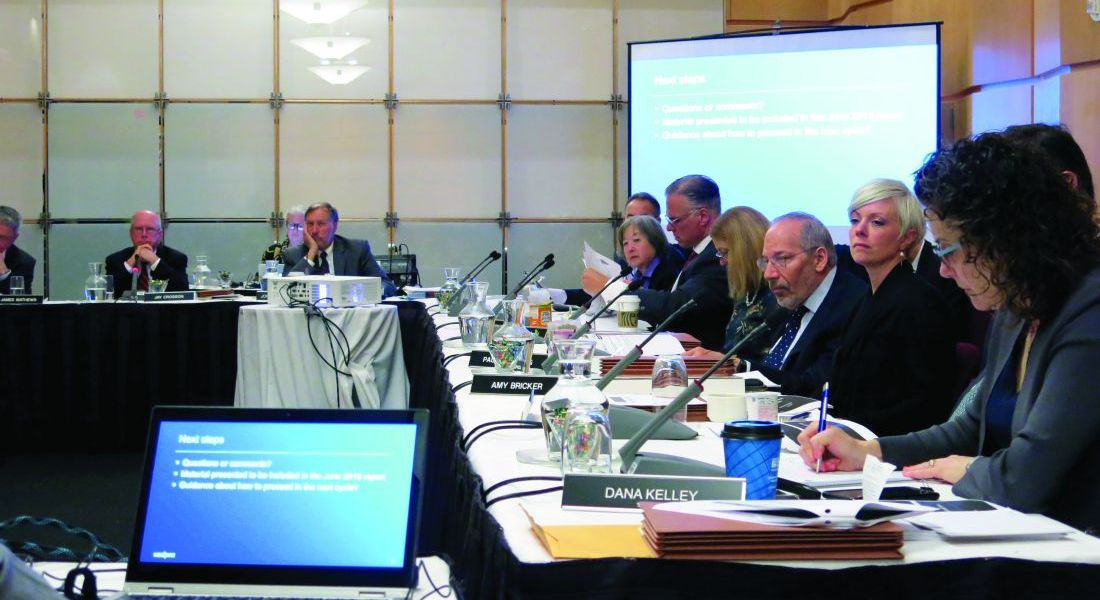
Commission members, after hearing about a pair of options related to affordability of specialty drugs and biologics, instructed staff to pursue the option that would essentially amount to an overhaul to the program.
Commission staff presented two options to the commission at a meeting on April 5. Gaining no traction was the easier of the two fixes that could be implemented rapidly – setting a maximum out-of-pocket limit on each specialty tier prescription. The staff used the lesser of a 33% coinsurance (which is generally calculated against the list price of the drug) or $200 for a 30-day supply as the limit.
That first option gained little traction with commission members, who instead gravitated to the option that would restructure the Part D prescription drug benefit to provide stronger formulary and pricing incentives.
As proposed, the second option would replace the coverage gap discount with a manufacturer “cap discount” and restructure the catastrophic benefit.
Commission staff members said that this would help provide stronger incentives for the use of generics, increase affordability for enrollees and the Medicare program, and provide stronger incentives for plans to manage spending. Staff members also said it could provide a disincentive for manufacturers to set high launch prices and/or increase prices rapidly.
The basic plan design would have 25% coinsurance after the deductible is met, up to a to-be-determined out-of-pocket threshold. This would be followed by catastrophic coverage, with details about who pays and how much still to be determined. Currently, the basic structure of the Part D program calls for plan members to pay a 5% coinsurance.
While speaking favorably about the concept of redesign, MedPAC member Kathy Buto, former vice president of global health policy at Johnson & Johnson, noted that it might be a tough sell.
“The difficulty we are going to have, or Medicare will have, in moving to something like this is that people are now entrenched in the current [program],” she said. “As much as I like this, I think it’s daunting moving from the current system.”
She said that if there is a focus on getting the benefits right, it will be a much better approach that could result in lower drug prices.
MedPAC member Amy Bricker, vice president of supply chain strategy at Express Scripts, called for consideration of additional reform to the current program’s six protected classes of drugs, within which plans are required to cover all or substantially all products.
She also suggested providing Part D plans with the ability to exclude high-priced drug launches from their formularies, something they cannot do now.
“Having the ability to exclude a product at launch is the single biggest tool that a commercial plan has and manufacturers fear,” she said, noting that it gives plans leverage, especially if there is little or no competition to that product.
Ms. Bricker came out against the consensus of other members of the commission and supported the out-of-pocket cap in addition to the overhauled Part D proposal.
She noted that the background material provided to the commission offered a suggestion that coinsurance would provide pressure on manufacturers to lower list prices because of the difficulty it puts on beneficiaries. “It doesn’t,” she said. “You can get a headline in the Wall Street Journal. You can hear about these stories in pockets. But it does not impact the decisions of the manufacturer.”
MedPAC staff will be working in the coming year to work out the details of the restructured proposal.
WASHINGTON – The Medicare Payment Advisory Commission will begin work on developing a plan to overhaul the Medicare Part D program.

Commission members, after hearing about a pair of options related to affordability of specialty drugs and biologics, instructed staff to pursue the option that would essentially amount to an overhaul to the program.
Commission staff presented two options to the commission at a meeting on April 5. Gaining no traction was the easier of the two fixes that could be implemented rapidly – setting a maximum out-of-pocket limit on each specialty tier prescription. The staff used the lesser of a 33% coinsurance (which is generally calculated against the list price of the drug) or $200 for a 30-day supply as the limit.
That first option gained little traction with commission members, who instead gravitated to the option that would restructure the Part D prescription drug benefit to provide stronger formulary and pricing incentives.
As proposed, the second option would replace the coverage gap discount with a manufacturer “cap discount” and restructure the catastrophic benefit.
Commission staff members said that this would help provide stronger incentives for the use of generics, increase affordability for enrollees and the Medicare program, and provide stronger incentives for plans to manage spending. Staff members also said it could provide a disincentive for manufacturers to set high launch prices and/or increase prices rapidly.
The basic plan design would have 25% coinsurance after the deductible is met, up to a to-be-determined out-of-pocket threshold. This would be followed by catastrophic coverage, with details about who pays and how much still to be determined. Currently, the basic structure of the Part D program calls for plan members to pay a 5% coinsurance.
While speaking favorably about the concept of redesign, MedPAC member Kathy Buto, former vice president of global health policy at Johnson & Johnson, noted that it might be a tough sell.
“The difficulty we are going to have, or Medicare will have, in moving to something like this is that people are now entrenched in the current [program],” she said. “As much as I like this, I think it’s daunting moving from the current system.”
She said that if there is a focus on getting the benefits right, it will be a much better approach that could result in lower drug prices.
MedPAC member Amy Bricker, vice president of supply chain strategy at Express Scripts, called for consideration of additional reform to the current program’s six protected classes of drugs, within which plans are required to cover all or substantially all products.
She also suggested providing Part D plans with the ability to exclude high-priced drug launches from their formularies, something they cannot do now.
“Having the ability to exclude a product at launch is the single biggest tool that a commercial plan has and manufacturers fear,” she said, noting that it gives plans leverage, especially if there is little or no competition to that product.
Ms. Bricker came out against the consensus of other members of the commission and supported the out-of-pocket cap in addition to the overhauled Part D proposal.
She noted that the background material provided to the commission offered a suggestion that coinsurance would provide pressure on manufacturers to lower list prices because of the difficulty it puts on beneficiaries. “It doesn’t,” she said. “You can get a headline in the Wall Street Journal. You can hear about these stories in pockets. But it does not impact the decisions of the manufacturer.”
MedPAC staff will be working in the coming year to work out the details of the restructured proposal.
WASHINGTON – The Medicare Payment Advisory Commission will begin work on developing a plan to overhaul the Medicare Part D program.

Commission members, after hearing about a pair of options related to affordability of specialty drugs and biologics, instructed staff to pursue the option that would essentially amount to an overhaul to the program.
Commission staff presented two options to the commission at a meeting on April 5. Gaining no traction was the easier of the two fixes that could be implemented rapidly – setting a maximum out-of-pocket limit on each specialty tier prescription. The staff used the lesser of a 33% coinsurance (which is generally calculated against the list price of the drug) or $200 for a 30-day supply as the limit.
That first option gained little traction with commission members, who instead gravitated to the option that would restructure the Part D prescription drug benefit to provide stronger formulary and pricing incentives.
As proposed, the second option would replace the coverage gap discount with a manufacturer “cap discount” and restructure the catastrophic benefit.
Commission staff members said that this would help provide stronger incentives for the use of generics, increase affordability for enrollees and the Medicare program, and provide stronger incentives for plans to manage spending. Staff members also said it could provide a disincentive for manufacturers to set high launch prices and/or increase prices rapidly.
The basic plan design would have 25% coinsurance after the deductible is met, up to a to-be-determined out-of-pocket threshold. This would be followed by catastrophic coverage, with details about who pays and how much still to be determined. Currently, the basic structure of the Part D program calls for plan members to pay a 5% coinsurance.
While speaking favorably about the concept of redesign, MedPAC member Kathy Buto, former vice president of global health policy at Johnson & Johnson, noted that it might be a tough sell.
“The difficulty we are going to have, or Medicare will have, in moving to something like this is that people are now entrenched in the current [program],” she said. “As much as I like this, I think it’s daunting moving from the current system.”
She said that if there is a focus on getting the benefits right, it will be a much better approach that could result in lower drug prices.
MedPAC member Amy Bricker, vice president of supply chain strategy at Express Scripts, called for consideration of additional reform to the current program’s six protected classes of drugs, within which plans are required to cover all or substantially all products.
She also suggested providing Part D plans with the ability to exclude high-priced drug launches from their formularies, something they cannot do now.
“Having the ability to exclude a product at launch is the single biggest tool that a commercial plan has and manufacturers fear,” she said, noting that it gives plans leverage, especially if there is little or no competition to that product.
Ms. Bricker came out against the consensus of other members of the commission and supported the out-of-pocket cap in addition to the overhauled Part D proposal.
She noted that the background material provided to the commission offered a suggestion that coinsurance would provide pressure on manufacturers to lower list prices because of the difficulty it puts on beneficiaries. “It doesn’t,” she said. “You can get a headline in the Wall Street Journal. You can hear about these stories in pockets. But it does not impact the decisions of the manufacturer.”
MedPAC staff will be working in the coming year to work out the details of the restructured proposal.
REPORTING FROM MEDPAC
ACR releases policy statements on drug pricing, step therapy
“We continue to emphasize these topics because they are so critical to the well-being of millions of Americans living with rheumatic diseases, some of which can be quite debilitating and even lead to death,” Colin Edgerton, MD, a rheumatologist at Low Country Rheumatology in South Carolina and chair of the ACR’s Committee on Rheumatologic Care, said in a statement. “The need for patients to have access to prompt, affordable, and medically necessary treatments is ongoing and should be considered at every step of the policy making process.”
The position statement on drug pricing calls for transparency in the policies used by pharmaceutical manufacturers, pharmacy benefit managers, and health insurance companies that determine drug prices.
To illustrate the need for transparency, the ACR pointed to the cost of adalimumab (Humira), a biologic medication that is used to treat a number of rheumatologic and other inflammatory conditions, which has seen its list price increase more than 100% during the past 5 years.
“The yearly price hike has dramatically outpaced inflation despite the lack of clinically significant modifications to the medication or major changes in the production process. The overall process of pricing and contracting is hidden from public view, such that the exact nature and profit margin taken by those involved is not disclosed to the largest stakeholder in the process, the patient,” the ACR stated.
The statement also calls for continued work on a safe and efficient biosimilar approval pathway and marketplace, which it says will help to improve access to drugs through lower costs.
“Any comprehensive proposal to deal with rising drug prices must simultaneously address these primary concerns: cost to the health care system, continuity of care, and out-of-pocket affordability to patients,” the position statement on drug pricing noted, adding that the organization “supports rational policies that mitigate rapid escalations in pricing of rheumatologic drugs.”
The position statement on step therapy notes that the ACR “does not support step therapy, fail-first policies, or tiering of medications based solely on cost,” and that access to drugs “should be timely and not impeded or delayed by unnecessary barriers.”
The organization noted that unregulated step therapy policies for targeted immune modulating agents (TIMs) “have hijacked the otherwise thoughtful and highly complex process that patients and their providers navigate when choosing appropriate therapy. While TIMs within a class may have similar effectiveness in large populations, responses by individual patients vary dramatically.”
The ACR called for transparency in the formulary decision-making process and for pharmacy review committees to include rheumatologists to help to develop formularies.
“The ACR welcomes the opportunity to provide expertise regarding rheumatic therapies to insurers,” the position statement said.
The organization also called for an end to nonmedical switching.
“Nonmedical switching between branded products and across therapeutic classes in a medically stable patient solely for cost savings and without the consent of the patient and his/her provider is inappropriate and potentially harmful to patients’ health,” the ACR said.
It expanded upon this position, noting that nonmedical switching occurs frequently and results in “adverse effects on treatment. In these situations, patients may unexpectedly be subjected to new step therapy requirements, forcing them to switch from their current medication to whatever agent is ‘preferred.’ ”
The ACR said the appeals process can take between 4 and 8 weeks and can be labor intensive, all the while putting the patient at harm for disease progression and physical damage.
“We continue to emphasize these topics because they are so critical to the well-being of millions of Americans living with rheumatic diseases, some of which can be quite debilitating and even lead to death,” Colin Edgerton, MD, a rheumatologist at Low Country Rheumatology in South Carolina and chair of the ACR’s Committee on Rheumatologic Care, said in a statement. “The need for patients to have access to prompt, affordable, and medically necessary treatments is ongoing and should be considered at every step of the policy making process.”
The position statement on drug pricing calls for transparency in the policies used by pharmaceutical manufacturers, pharmacy benefit managers, and health insurance companies that determine drug prices.
To illustrate the need for transparency, the ACR pointed to the cost of adalimumab (Humira), a biologic medication that is used to treat a number of rheumatologic and other inflammatory conditions, which has seen its list price increase more than 100% during the past 5 years.
“The yearly price hike has dramatically outpaced inflation despite the lack of clinically significant modifications to the medication or major changes in the production process. The overall process of pricing and contracting is hidden from public view, such that the exact nature and profit margin taken by those involved is not disclosed to the largest stakeholder in the process, the patient,” the ACR stated.
The statement also calls for continued work on a safe and efficient biosimilar approval pathway and marketplace, which it says will help to improve access to drugs through lower costs.
“Any comprehensive proposal to deal with rising drug prices must simultaneously address these primary concerns: cost to the health care system, continuity of care, and out-of-pocket affordability to patients,” the position statement on drug pricing noted, adding that the organization “supports rational policies that mitigate rapid escalations in pricing of rheumatologic drugs.”
The position statement on step therapy notes that the ACR “does not support step therapy, fail-first policies, or tiering of medications based solely on cost,” and that access to drugs “should be timely and not impeded or delayed by unnecessary barriers.”
The organization noted that unregulated step therapy policies for targeted immune modulating agents (TIMs) “have hijacked the otherwise thoughtful and highly complex process that patients and their providers navigate when choosing appropriate therapy. While TIMs within a class may have similar effectiveness in large populations, responses by individual patients vary dramatically.”
The ACR called for transparency in the formulary decision-making process and for pharmacy review committees to include rheumatologists to help to develop formularies.
“The ACR welcomes the opportunity to provide expertise regarding rheumatic therapies to insurers,” the position statement said.
The organization also called for an end to nonmedical switching.
“Nonmedical switching between branded products and across therapeutic classes in a medically stable patient solely for cost savings and without the consent of the patient and his/her provider is inappropriate and potentially harmful to patients’ health,” the ACR said.
It expanded upon this position, noting that nonmedical switching occurs frequently and results in “adverse effects on treatment. In these situations, patients may unexpectedly be subjected to new step therapy requirements, forcing them to switch from their current medication to whatever agent is ‘preferred.’ ”
The ACR said the appeals process can take between 4 and 8 weeks and can be labor intensive, all the while putting the patient at harm for disease progression and physical damage.
“We continue to emphasize these topics because they are so critical to the well-being of millions of Americans living with rheumatic diseases, some of which can be quite debilitating and even lead to death,” Colin Edgerton, MD, a rheumatologist at Low Country Rheumatology in South Carolina and chair of the ACR’s Committee on Rheumatologic Care, said in a statement. “The need for patients to have access to prompt, affordable, and medically necessary treatments is ongoing and should be considered at every step of the policy making process.”
The position statement on drug pricing calls for transparency in the policies used by pharmaceutical manufacturers, pharmacy benefit managers, and health insurance companies that determine drug prices.
To illustrate the need for transparency, the ACR pointed to the cost of adalimumab (Humira), a biologic medication that is used to treat a number of rheumatologic and other inflammatory conditions, which has seen its list price increase more than 100% during the past 5 years.
“The yearly price hike has dramatically outpaced inflation despite the lack of clinically significant modifications to the medication or major changes in the production process. The overall process of pricing and contracting is hidden from public view, such that the exact nature and profit margin taken by those involved is not disclosed to the largest stakeholder in the process, the patient,” the ACR stated.
The statement also calls for continued work on a safe and efficient biosimilar approval pathway and marketplace, which it says will help to improve access to drugs through lower costs.
“Any comprehensive proposal to deal with rising drug prices must simultaneously address these primary concerns: cost to the health care system, continuity of care, and out-of-pocket affordability to patients,” the position statement on drug pricing noted, adding that the organization “supports rational policies that mitigate rapid escalations in pricing of rheumatologic drugs.”
The position statement on step therapy notes that the ACR “does not support step therapy, fail-first policies, or tiering of medications based solely on cost,” and that access to drugs “should be timely and not impeded or delayed by unnecessary barriers.”
The organization noted that unregulated step therapy policies for targeted immune modulating agents (TIMs) “have hijacked the otherwise thoughtful and highly complex process that patients and their providers navigate when choosing appropriate therapy. While TIMs within a class may have similar effectiveness in large populations, responses by individual patients vary dramatically.”
The ACR called for transparency in the formulary decision-making process and for pharmacy review committees to include rheumatologists to help to develop formularies.
“The ACR welcomes the opportunity to provide expertise regarding rheumatic therapies to insurers,” the position statement said.
The organization also called for an end to nonmedical switching.
“Nonmedical switching between branded products and across therapeutic classes in a medically stable patient solely for cost savings and without the consent of the patient and his/her provider is inappropriate and potentially harmful to patients’ health,” the ACR said.
It expanded upon this position, noting that nonmedical switching occurs frequently and results in “adverse effects on treatment. In these situations, patients may unexpectedly be subjected to new step therapy requirements, forcing them to switch from their current medication to whatever agent is ‘preferred.’ ”
The ACR said the appeals process can take between 4 and 8 weeks and can be labor intensive, all the while putting the patient at harm for disease progression and physical damage.
Cigna, Express Scripts to offer $25 cap on 30-day insulin supply
Cigna and Express Scripts have announced
The new program, open to Cigna members who are covered in commercial plans, would cap out-of-pocket costs for a 30-day supply of insulin at $25. For plan members, the only eligibility requirement is having an out-of-pocket cost higher than $25, according to a press release.
For a member to participate in the program, the plan administrator at the member’s place of employment has to opt in to it. There are no eligibility requirements imposed on the employer, other than a willingness to opt in.
A spokeswoman for Express Scripts said that there is no charge to sign up for the program, and most plans will not see an additional cost to get the copayment to $25 for the patient.
The announcement comes in the wake of the first of two hearings by the House Committee on Energy & Commerce aimed at understanding why insulin prices have spiked in recent years. The first hearing, held on April 2, examined the impact that the high list price of insulin is having on patients, and how out-of-pocket expenses are limiting access to this life-saving drug. The second hearing, expected to occur during the week of April 8 (the date had not been scheduled as of press time), will bring together various players in the supply chain, including the three major manufacturers of insulin.
“We are confident that our new program will remove cost as a barrier for people in participating plans who need insulin,” Steve Miller, MD, executive vice president and chief clinical officer at Cigna, said in a statement.
The Express Scripts spokeswoman noted that there were more than 700,000 people in a commercially insured plan across Cigna and Express Scripts who had a claim for insulin in 2018. The average out-of-pocket cost of a 30-day supply of insulin in 2018 across this population was $41.50.
Cigna and Express Scripts have announced
The new program, open to Cigna members who are covered in commercial plans, would cap out-of-pocket costs for a 30-day supply of insulin at $25. For plan members, the only eligibility requirement is having an out-of-pocket cost higher than $25, according to a press release.
For a member to participate in the program, the plan administrator at the member’s place of employment has to opt in to it. There are no eligibility requirements imposed on the employer, other than a willingness to opt in.
A spokeswoman for Express Scripts said that there is no charge to sign up for the program, and most plans will not see an additional cost to get the copayment to $25 for the patient.
The announcement comes in the wake of the first of two hearings by the House Committee on Energy & Commerce aimed at understanding why insulin prices have spiked in recent years. The first hearing, held on April 2, examined the impact that the high list price of insulin is having on patients, and how out-of-pocket expenses are limiting access to this life-saving drug. The second hearing, expected to occur during the week of April 8 (the date had not been scheduled as of press time), will bring together various players in the supply chain, including the three major manufacturers of insulin.
“We are confident that our new program will remove cost as a barrier for people in participating plans who need insulin,” Steve Miller, MD, executive vice president and chief clinical officer at Cigna, said in a statement.
The Express Scripts spokeswoman noted that there were more than 700,000 people in a commercially insured plan across Cigna and Express Scripts who had a claim for insulin in 2018. The average out-of-pocket cost of a 30-day supply of insulin in 2018 across this population was $41.50.
Cigna and Express Scripts have announced
The new program, open to Cigna members who are covered in commercial plans, would cap out-of-pocket costs for a 30-day supply of insulin at $25. For plan members, the only eligibility requirement is having an out-of-pocket cost higher than $25, according to a press release.
For a member to participate in the program, the plan administrator at the member’s place of employment has to opt in to it. There are no eligibility requirements imposed on the employer, other than a willingness to opt in.
A spokeswoman for Express Scripts said that there is no charge to sign up for the program, and most plans will not see an additional cost to get the copayment to $25 for the patient.
The announcement comes in the wake of the first of two hearings by the House Committee on Energy & Commerce aimed at understanding why insulin prices have spiked in recent years. The first hearing, held on April 2, examined the impact that the high list price of insulin is having on patients, and how out-of-pocket expenses are limiting access to this life-saving drug. The second hearing, expected to occur during the week of April 8 (the date had not been scheduled as of press time), will bring together various players in the supply chain, including the three major manufacturers of insulin.
“We are confident that our new program will remove cost as a barrier for people in participating plans who need insulin,” Steve Miller, MD, executive vice president and chief clinical officer at Cigna, said in a statement.
The Express Scripts spokeswoman noted that there were more than 700,000 people in a commercially insured plan across Cigna and Express Scripts who had a claim for insulin in 2018. The average out-of-pocket cost of a 30-day supply of insulin in 2018 across this population was $41.50.
ONC’s Dr. Rucker: Era of provider-controlled data is over
“The era of the provider controlling all of this, I think this is over,” Donald Rucker, MD, head of the Office of the National Coordinator (ONC) for Health Information Technology within the Department of Health and Human Services, said at an annual conference on health data and innovation. We need a “formal path to put patients back in control of their medical data.”
That path can be found in a pair of proposed rules issued earlier this year, one from the Centers for Medicare & Medicaid Services and the other from ONC, that are designed to give patients that control.
With smartphone apps under development that will allow patient access to health care data from a single point of entry, “technology now allows us to move from having to go portal to portal to portal to really having us in control,” Dr. Rucker said. “I think it is going to transform [health care] in the same way that the smartphone app has transformed other sectors. We are very excited about that.”
Access to data and information should further the transition to value-based care as patients become the center of the decision tree, Dr. Rucker said, making decisions based on benefits in a way that is not possible now.
“In particular, we think patients are going to start being able to shop for care,” he said, adding that if “they don’t like the price of the care they are getting, they are going to be able to move their business elsewhere.”
To that end, he said that much of the talk about interoperability “is really a conversation about affordability and the vast expenses in health care and how you get some control over that.”
“The era of the provider controlling all of this, I think this is over,” Donald Rucker, MD, head of the Office of the National Coordinator (ONC) for Health Information Technology within the Department of Health and Human Services, said at an annual conference on health data and innovation. We need a “formal path to put patients back in control of their medical data.”
That path can be found in a pair of proposed rules issued earlier this year, one from the Centers for Medicare & Medicaid Services and the other from ONC, that are designed to give patients that control.
With smartphone apps under development that will allow patient access to health care data from a single point of entry, “technology now allows us to move from having to go portal to portal to portal to really having us in control,” Dr. Rucker said. “I think it is going to transform [health care] in the same way that the smartphone app has transformed other sectors. We are very excited about that.”
Access to data and information should further the transition to value-based care as patients become the center of the decision tree, Dr. Rucker said, making decisions based on benefits in a way that is not possible now.
“In particular, we think patients are going to start being able to shop for care,” he said, adding that if “they don’t like the price of the care they are getting, they are going to be able to move their business elsewhere.”
To that end, he said that much of the talk about interoperability “is really a conversation about affordability and the vast expenses in health care and how you get some control over that.”
“The era of the provider controlling all of this, I think this is over,” Donald Rucker, MD, head of the Office of the National Coordinator (ONC) for Health Information Technology within the Department of Health and Human Services, said at an annual conference on health data and innovation. We need a “formal path to put patients back in control of their medical data.”
That path can be found in a pair of proposed rules issued earlier this year, one from the Centers for Medicare & Medicaid Services and the other from ONC, that are designed to give patients that control.
With smartphone apps under development that will allow patient access to health care data from a single point of entry, “technology now allows us to move from having to go portal to portal to portal to really having us in control,” Dr. Rucker said. “I think it is going to transform [health care] in the same way that the smartphone app has transformed other sectors. We are very excited about that.”
Access to data and information should further the transition to value-based care as patients become the center of the decision tree, Dr. Rucker said, making decisions based on benefits in a way that is not possible now.
“In particular, we think patients are going to start being able to shop for care,” he said, adding that if “they don’t like the price of the care they are getting, they are going to be able to move their business elsewhere.”
To that end, he said that much of the talk about interoperability “is really a conversation about affordability and the vast expenses in health care and how you get some control over that.”
REPORTING FROM HEALTH DATAPALOOZA 2019





